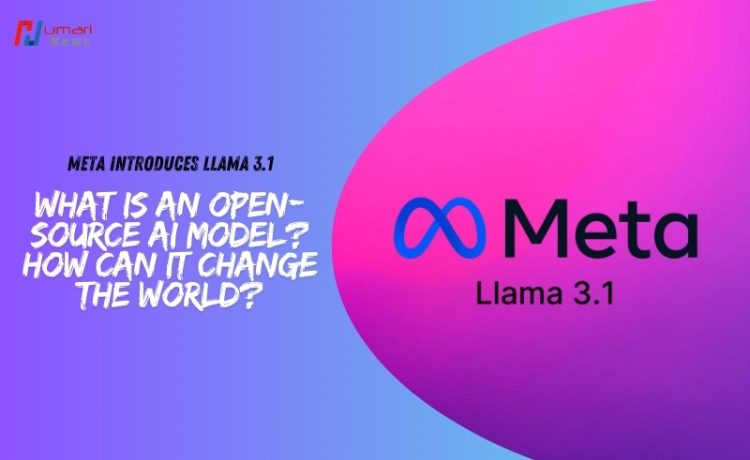Meta, formerly known as Facebook, is making headlines once again with the launch of its newest open-source AI model, Llama 3.1. This groundbreaking development has left the tech world buzzing with excitement as Meta appears poised to revolutionize the landscape of artificial intelligence.
But what exactly is an open-source AI model, and how can it change the world? Let’s delve deeper into the realm of open-source AI and explore Meta’s latest innovation.
Understanding Open-Source AI
What is an open-source AI model?
An open-source AI model is an artificial intelligence technology that is publicly available for both commercial and non-commercial use under various open-source licenses.
This means that developers have access to the inner workings of the AI system, allowing them to study, modify, and share its components. Open-source AI models typically come equipped with datasets, interfaces, and algorithms that facilitate app development and customization.
Advantages of Open Source AI
One of the key advantages of open source AI models is the flexibility and control they offer to developers. Organizations can tailor these models to suit their unique requirements, whether they are working on on-device tasks or managing complex operations. This level of customization allows for greater efficiency and innovation in AI development.
The Rise of Open Source AI
Open source AI refers to artificial intelligence technology that is freely available for both commercial and non-commercial use under various open-source licenses. This means that developers have access to the model’s components, allowing them to study how it works and customize it according to their specific needs.
How is Meta’s Llama 3.1 different from its peers?
Meta’s Llama 3.1 stands out as the company’s largest open-source AI model to date. It has been designed to outperform rival models such as OpenAI’s GPT-4o and Anthropic’s Claude 3.5 Sonnet.
The new Llama 3.1 models boast increased complexity and improved performance over their predecessors, making them a formidable force in the AI arena.
The Implications of Llama 3.1
Meta CEO Mark Zuckerberg envisions Llama 3.1 as a game-changer in the world of AI. He predicts that Meta’s AI assistant, powered by Llama technology, will soon surpass ChatGPT as the most widely used AI assistant globally.
With models like Llama 3.1 405B, Meta aims to offer cost-effective AI solutions that outshine closed models in terms of performance and accessibility.
Why is Meta championing open-source AI?
Zuckerberg emphasizes the importance of open-source AI in driving innovation and empowering developers to create exceptional products and services. By sharing the Llama model with the public, Meta hopes to cultivate a vibrant ecosystem of tools and enhancements that will fuel long-term technological advancement.
Additionally, open-source AI models promote transparency, security, and cost-effectiveness, making them an attractive option for organizations seeking to maximize their AI capabilities.
FAQs about Llama 3.1:
1. What do we know about Llama 3.1?
Llama 3.1 is Meta’s most extensive open-source AI model to date, boasting enhanced capabilities and performance metrics compared to its predecessors. Meta has positioned Llama 3.1 as a game-changer in the AI landscape, offering cost-effective solutions and robust security features. With multiple variants of the Llama 3.1 model available, developers can choose the model that best suits their needs, whether it be fine-tuning small models or running inference operations efficiently.
2. Why is Meta advocating for open-source AI?
Meta’s CEO, Mark Zuckerberg, has emphasized the importance of open-source AI in driving innovation, enhancing security, and fostering a more inclusive technology ecosystem. By embracing open-source principles, Meta aims to lead the way in democratizing AI technologies and empowering a diverse range of stakeholders, from startups to academic institutions. The affordability, transparency, and scalability of open-source AI models like Llama 3.1 pave the way for groundbreaking advancements and widespread adoption across industries.
3. How can open source AI models change the world?
Open-source AI models have the potential to revolutionize how we approach technology and innovation on a global scale. By making AI technology more accessible, transparent, and customizable, open-source models like Llama 3.1 enable developers to create innovative solutions tailored to specific needs. This democratization of AI empowers a broader community of creators and innovators to harness the full potential of artificial intelligence, driving progress, and fostering collaboration across diverse sectors.
Conclusion:
In conclusion, Meta’s introduction of Llama 3.1 marks a significant milestone in the realm of open-source AI. With its superior performance, cost-effectiveness, and commitment to fostering innovation, Llama 3.1 has the potential to shape the future of artificial intelligence and drive positive change on a global scale. As Meta continues to lead the charge in open-source AI development, the possibilities for transformative advancements in technology are endless.







